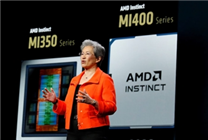AMD’s Next-Generation AI Accelerator: The MI450
Key Insights
- World’s First: AMD’s MI450 will be the first AI accelerator card manufactured using a groundbreaking 2nm process.
- Powerful Performance: The MI450 aims to outperform competitors by providing enhanced FP8 and FP4 computing power alongside increased memory capacity.
- Strategic Competition: Set to challenge NVIDIA’s Ruby, the MI450 positions AMD as a formidable player in the AI computing landscape.
In a significant announcement, AMD’s CEO, Dr. Su Zifeng, confirmed that the upcoming Instinct MI450 will make history as the world’s first AI accelerator card leveraging a 2nm manufacturing process. This innovative product is slated for release in the next year, marking a crucial milestone for AMD and the tech industry at large.
The 2nm Breakthrough
This advancement in technology follows Dr. Su’s earlier statement in April, where she revealed the launch of the sixth-generation EPYC data center processor, codenamed Venice. This model is also poised to employ TSMC’s cutting-edge N2 2nm process and has already completed its tape-out phase. The impending release of both the Venice EPYC and the MI450 marks the establishment of AMD’s new AI computing platform, heralding a new era of high-performance computing.
The significance of the MI450 is further underscored by its unique architectural features. While the XCD core module of the accelerator will utilize the pioneering 2nm process, other components such as the AID intermediary layer and the MID media interface module will be produced using TSMC’s N3P process. This strategic choice is designed to optimize performance while remaining at the forefront of semiconductor technology.
A Direct Challenge to Competitors
AMD’s MI450 will enter a competitive arena as it goes head-to-head with NVIDIA’s Ruby, which remains reliant on TSMC’s N3P process. Both companies are racing to capture a significant share of the AI computing market, which is rapidly expanding due to the increasing demand for high-performance data processing.
AMD has expressed confidence in its MI450’s capabilities, claiming that it offers comparable computing power in terms of FP8 and FP4 metrics, but with a distinct advantage in memory bandwidth and capacity. The MI450 is expected to feature HBM4 memory, which promises superior performance characteristics over rival products.
The Future of AI Computing
As the landscape of AI computing evolves, AMD’s commitment to innovation and performance promises to reshape industry standards. The alignment of the MI450 with the Venice EPYC processor not only strengthens AMD’s product offerings but also positions the company as a leader in the AI accelerator market.
By integrating cutting-edge technology and strategic manufacturing processes, AMD is poised to deliver a powerful solution for AI developers and data centers alike. With the MI450, AMD aims to streamline artificial intelligence operations, facilitating more efficient data processing and enhancing overall performance.
In conclusion, AMD’s MI450 represents a bold step forward in the realm of AI accelerated computing. Its unique technological foundations and strategic competition against established players signal a promising future for both the company and the industry.
Summary
The AMD MI450 is set to change the AI computing game with its 2nm process technology and higher memory capacity. By directly competing with NVIDIA, it showcases AMD’s commitment to advancing semiconductor innovation. As the release date approaches, all eyes will be on AMD’s capabilities to deliver performance that meets the rising demands of AI applications.




